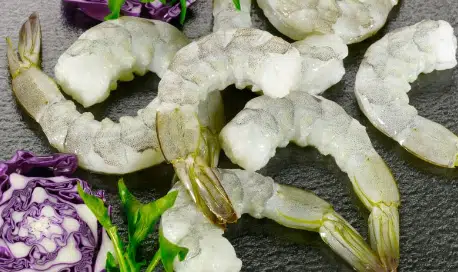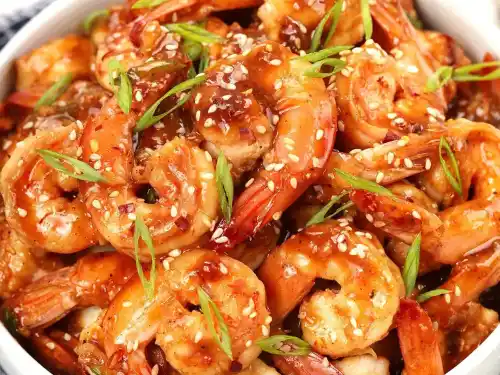It is a fact that we all love frozen shrimp. However, we also can’t ignore the fact that frozen shrimp may make us gain weight and have blood pressure. The sodium content in some frozen shrimp is huge and unhealthy for human health. So if you like eating some shrimp but don’t want to be overweight and ill, you should definitely try these methods in this article on how to remove sodium from frozen shrimp to reduce its salt content.
To remove sodium from frozen shrimp:
- Rinse each shrimp individually under tap water to wash off the excess sodium crystals, which are also known as salt.
- Toss any leftover shrimp that may not have thawed throughout the thawing process.
- Pat the shrimp dry after cleaning to remove any excess water that could potentially lead to spoiling or mushiness.
Frozen shrimp can usually be found in most supermarkets, and if you live on the coast of the Gulf of Mexico, it is common. But whether you live by the sea or just love seafood, frozen shrimp is one food that shouldn’t be ignored.
How to remove sodium from frozen shrimp – Methods to use
1. Rinse frozen shrimp under cold running water
Rinse under running water for 5–10 seconds and thoroughly pat dry before using in your recipe. Freezing preserves the taste and texture of the shrimp and is a great way to buy plenty and store them for future use. Sodium in frozen shrimp does not leach out significantly when cooked but is removed by washing it with cold water.
Properly rinsing frozen shrimp is essential to remove brine or sodium from the shrimp. Rinsing the shrimp under cold running water helps remove any residual brine or sodium from the packaging, making it a better nutritional choice for your diet. Adding a little fresh lemon juice to the running water helps remove even more brine residue. Enjoy your rinsed frozen shrimp as a healthy snack or as a component in soups, salads, stir-frys, and stews.
2. Thaw frozen shrimp in cold water to remove sodium
Thaw the frozen shrimp in cold water. The sodium from the seafood can drain out freely due to the low temperature. You can get this method ready by placing small plates of ice under the cooling water, so it stays cool enough for the shrimp to thaw without spoiling.
Get fresh cold water and toss the shrimp; the cold water will help remove the sodium from the shrimp. Serve up those healthy, delicious shrimp without all the unnecessary salt.
3. Rinse with lemon juice, water, and peeled potato
Defrost the shrimp and rinse with lemon juice or clean water to remove some of the salt. For extra flavor, chive your shrimp before cooking it, peel the potato’s skin and put it in the middle of the shrimp. Wrap them together with aluminum foil and bake them in the oven at 500 Fahrenheit for 10 minutes; let them cool down the shrimp’s salty taste will be light.
4. Boiling the frozen shrimp
The best way to remove the sodium from frozen shrimp is to boil them before consuming them. The boiling water can reduce sodium by up to 40%. Boiling the frozen shrimp is an extremely effective method, while not the most convenient, removing a good deal of salt from the product. A pressure cooker can also be an alternative to remove extra salt. If you no longer want to use the frozen shrimp in its original recipe, consider cutting it into pieces and adding it to another dish, such as soups or salads.
How to deshell frozen shrimp

To deshell frozen shrimp from its original pack, you need to clean it first. Using a pair of pliers, hold the shrimp with the tail facing upward, then forcibly pull away from the outer shelled. After removing this shell, rinse the peeled shrimp with clean water to remove any dirt or impurities on the surface. Now your peeled shrimp are ready for cooking or frying.
How to cook frozen shrimp

1. Boiling frozen shrimp
To cook frozen shrimp, start by thawing them in cold water. Then, begin boiling 12 cups of water with 1 tablespoon salt per every 2 cups of water. After getting the water to a boil, add the entire bag of shrimp into the pot. Boil for about 5 minutes until the water returns to a simmer. Cook any longer than that, and the shrimp will start to toughen.
Shrimp is delicious, but if you forget to defrost them before you’re ready to cook them, it will take a longer time to thaw out. Yogurt, marinating, and other tricks will speed up the process.
2. Poaching frozen shrimp
Poaching frozen shrimp is a great way to enjoy shrimp that you have previously frozen. It takes less time to cook than boiling or steaming and produces nice, tender shrimp with little work.
Poach shrimp by placing them in a bowl of ice-cold water with a tablespoon of vinegar, stirring occasionally. Poach for about 4 minutes or until they turn pink and opaque, do not allow to cook thoroughly. Remove from the Ice bath and place between layers of paper towels to remove excess water, then cut in half and remove the veins.
3. Grilling frozen shrimp
Grilling frozen shrimp is a great way to make tasty and succulent shrimp. Whether you want to turn them into appetizers or meals, this is a hassle-free way to enjoy delicious seafood.
To grill frozen shrimp, start by boiling them in salty water for three minutes. This will kill bacteria already on the shell. Then drain, rinse in cold water, and let evaporate to reduce moisture. Pat the shrimp dry with a paper towel or cloth.
Thread them onto skewers or place them in a bowl for grilling without skewers to prevent the meat from spinning around the stick when they come in contact with the hot grill. Sprinkle salt and pepper on for better taste, if desired.
Now you’re ready to cook. Place your prepared shrimp under your pre-heated charcoal or gas grill over medium heat. Grill it for 2 minutes per side. Some shells may turn pink when they’re finished. Serve with lemon wedges.
Frequently Asked Questions
Does soaking shrimp in water reduce sodium?
No, but this is an old myth that has not been backed up by scientific evidence. It is true that shrimp are very high in sodium, but scientific evidence shows that soaking them in water will not reduce sodium content to a level considered healthy.
How do you make shrimp less salty?
Soak your shrimp in a water and baking soda solution for up to 2 hours, and thereby remove up to 98% of their salt.
Is frozen shrimp high in sodium?
Generally, shrimp has a very high sodium content, and frozen shrimps can be even higher (in some cases, frozen shrimp may contain nearly twice as much sodium as fresh shrimp). Shrimp is also very salty seafood that is naturally high in sodium, and the additive of salt used in the freezing process only adds to the problem of high sodium content.
Is cooked shrimp high in sodium?
Cooking shrimp can significantly raise the sodium level in a dish, although this occurs only when the shrimp is prepared in an extremely salty sauce. The salt content of shrimp depends on how it has been processed. In general, canned shrimp contains approximately 250 milligrams of sodium per 3-ounce serving, while pre-cooked, frozen shrimp may contain around 1130 milligrams of sodium or more per serving.
Are eggs high in sodium?
No, eggs are not high in sodium. Adults should eat foods containing less than 1,500mg of sodium per day. One egg has only 80mg of sodium, which is just two percent of the recommended daily allowance which means one egg contributes less than 10 percent of the recommended daily allowance of sodium.
Conclusion
Removing salts from frozen shrimp is possible to do so. It is a simple process that can be performed in a matter of minutes. Knowing how to remove sodium from frozen shrimp makes it a great addition to a low-carb diet or for anyone trying to cut back on sodium intake.

Equipment
- 1 Pan
Ingredients
- 1 tablespoon olive oil
- 1 lb medium to large shrimp peeled and deveined
- ¼ cup low-sodium soy sauce
- 2 tablespoon water
- 2 tablespoon light brown sugar
- 1 tablespoon honey
- 1 tablespoon rice vinegar
- 1 teaspoon sesame oil
- 3 garlic cloves minced
- 1 teaspoon fresh ginger grated
- 1 green onion diced
- 1 tablespoon toasted sesame seeds
- 1 tablespoon water
- 1 tablespoon cornstarch
Instructions
- Say sauce, water, brown sugar, honey, rice vinegar, garlic, ginger, green onions, and sesame seeds should all be combined in a small bowl.
- Large skillet with oil over medium-high heat. Once the shrimp is added, heat it until pink, about 1-2 minutes per side.
- Take the shrimp out of the pan, then add the teriyaki sauce and heat through.
- The tablespoon of water and cornstarch should be thoroughly combined in a small bowl before being added to the sauce. Simmer until thick, about 1-2 minutes.
- To uniformly coat the shrimp with the sauce, place them back. If desired, serve with rice and vegetables.



